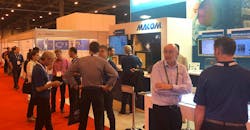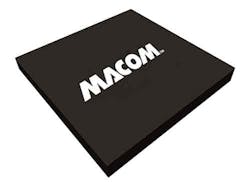Keep an Eye on These New Products for Your Next Project
At the recent European Microwave Week (EuMW), MACOM was among the companies that made its presence felt with the unveiling of three new products. These are the latest in a series of launches by the company.
“In the recently completed fiscal year, we released 64 new products,” says Graham Board, senior director of product marketing at MACOM. “They span everything from traveling-wave amplifiers (dc-to-28 GHz and dc-to-50 GHz amplifiers) to voltage-variable attenuators (VVAs), digital step attenuators (DSAs), and detectors. What we’ve really been focused on are all the key building blocks that you need in the RF signal chain. We’re developing parts for markets like millimeter-wave (mmWave) connectivity, aerospace and defense, test and measurement, and satellite-communications (satcom).”
One of the announcements made by MACOM during EuMW is the MAAL-011141 wideband low-noise amplifier (LNA). The MAAL-011141 is a packaged version of the previously released MAAL-011141-DIE amplifier. “A strategy that allows us to engage in disparate markets has been to offer different packaging concepts,” explains Board. “There are customers who prefer packaged devices because of the ease of manufacturing. But for others in the aerospace-and-defense space, bare die formats are very important because they’re building modules. So, we offer both.
“In the case of the MAAL-011141 LNA, we released it in a bare die format. The response to that was such that it made sense for us to also release it as a packaged part because there was so much interest.”
Covering a frequency range of dc to 28 GHz, the MAAL-011141 has a typical gain of 17.5 dB across most of the band. At 8 GHz, it achieves a typical noise figure of 1.4 dB. Housed in a 5-mm, 32-lead AQFN package, the MAAL-011141 is well-suited for test-and-measurement, electronic-warfare (EW), electronic-countermeasures (ECM), and radar applications.
1. The MASW-011102 SPDT switch, which operates from dc to 30 GHz and maintains 1.8 dB of insertion loss across the entire band, comes in a PQFN package as shown here.
Also announced was the MASW-011102, a new single-pole/double-throw (SPDT) switch that operates from dc to 30 GHz (Fig. 1). At 30 GHz, the MASW-011102 achieves an insertion loss of 1.8 dB along with an isolation of 40 dB. Furthermore, MACOM emphasizes the component’s fast switching speed of 40 ns. Housed in a 3-mm, 14-lead PQFN package, the MASW-011102 is intended for applications like test and measurement, EW, and broadband communication systems.
Lastly, MACOM announced its new MACP Series of power detectors, comprised of the MACP-010571, MACP-010572, and MACP-010573. Each of the MACP Series detectors feature an integrated directional coupler along with built-in temperature compensation. The detectors are intended for power monitoring and leveling for a wide range of applications, such as point-to-point radios, radar systems, EW systems, and more.
The MACP-010571 covers a frequency range of 2 to 6 GHz, and the MACP-010572 operates from 6 to 18 GHz. The MACP-010573 handles frequencies ranging from 10 to 30 GHz. The minimum detectable power level of the MACP-010571 is −15 dBm at 4 GHz; for the MACP-010572, it’s −16 dBm at 12 GHz; and for the MACP-010573, the minimum is −18 dBm at 20 GHz. Each detector is housed in a 1.5- × 1.2-mm 6-lead TDFN plastic package.
Beyond EuMW
As Board mentioned, MACOM released a number of new products during the last fiscal year. One new product portfolio to be aware of is the MLPNC Series of comb generators announced during IMS 2018 (Fig. 2). The MLPNC Series is based on nonlinear-transmission-line (NLTL) technology.
2. The MLPNC Series of comb generators is based on nonlinear-transmission-line technology.
Board says, “The comb generator is addressing the market’s need for very-low-phase-noise sources. Our NLTL-based combs can be paired with ovenized crystal oscillators at low frequencies. There are many aerospace-and-defense applications in which a system may have multiple local oscillators (LOs). One of our combs would potentially address the requirement for multiple LOs. In fact, there’s an application that has 20 individual LOs in a system. One of our combs addresses that requirement, providing a very clean multiplied signal with higher output power than a step-recovery diode (SRD) along with really low phase noise.”
MACOM offers both surface-mount technology (SMT) and connectorized versions of the MLPNC Series comb generators. The series consists of several variants, such as the MLPNC-7100. This model, available as either an SMT or connectorized component, has an input frequency range of 100 to 400 MHz. The specified input power level ranges from +18 to +24 dBm. Furthermore, the MLPNC-7100 is rated for output harmonics at frequencies as high as 20 GHz. Visit MACOM’s website for more information on the remaining MLPNC models.



